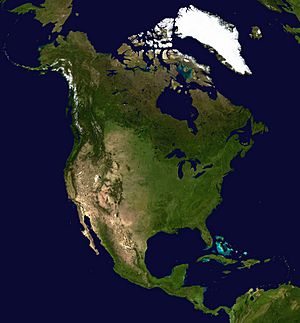Turtle Island (Native American folklore) facts for kids
Turtle Island is a special name for Earth or North America. Many Indigenous peoples use this name. It's also used by people who work for Indigenous rights. The name comes from an old story about how the world was made. In some cultures, Turtle Island means the same thing as "North America."
Contents
The Story of Turtle Island
Many Indigenous groups have stories about how the world was created on the back of a giant turtle. These stories are very old and have been passed down through many generations.
Lenape People's Story
The Lenape people have a story about a "Great Turtle." Europeans first wrote down this story between 1678 and 1680. Other tribes in the Northeastern Woodlands, like those in the Iroquois Confederacy, share similar stories.
Haudenosaunee People's Story
The Iroquois people, also known as the Haudenosaunee, have a well-known story. They say that long ago, the earth was covered by a "great cloud sea." A being called Sky Woman fell from a peaceful island in the sky down towards this water.
Many animals tried to help her. They tried to dive deep into the ocean to bring up dirt to make land. The muskrat was the one who finally succeeded. It brought up a small amount of dirt. This dirt was placed on the back of a giant turtle.
The dirt began to grow and spread, and the turtle also grew bigger and bigger. The dirt kept multiplying until it became a huge landmass. This is why the Iroquois people often call the earth Turtle Island.
In the Seneca language, the mythical turtle is called Hah-nu-nah. A regular turtle is called ha-no-wa.
Some versions of the story, like one by Susan M. Hills, say that animals like the muskrat might even give their lives to find the dirt. This shows how death and giving back to the land are important parts of creation for the Haudenosaunee. It's believed that our bodies return to the soil to help new life grow.
For example, in some tellings, Sky Woman's daughter dies while giving birth. She is the first person buried on the turtle's back. From her burial spot, important plants like corn and strawberries grew. This shows how the land itself can help create and shape life.
Turtle Island in Modern Times
The name Turtle Island is used by many Indigenous cultures today. It's also used by both Indigenous and non-Indigenous activists, especially since the 1970s.
Protecting the Earth
Many people use the name Turtle Island when talking about protecting the environment. American writer Gary Snyder used the term to talk about North America. He believed that using this Indigenous name could help people think differently about the continent.
The name Turtle Island has appeared in many works. These include Snyder's book of poetry, Turtle Island, which won a Pulitzer Prize for Poetry. It's also the name of a jazz music group, the Turtle Island Quartet.
Acknowledging Traditional Lands
In Canada, many universities and organizations start meetings or events by acknowledging the traditional Indigenous territories they are on. Sometimes, they mention Turtle Island as part of this acknowledgment. This helps everyone remember the long history of Indigenous peoples on the land.
Names in Indigenous Languages
Here are some ways different Indigenous languages say Turtle Island:
- Anishinaabemowin: Mishiike Minisi, Mikinoc Waajew
- Kanyenʼkéha: Anowara:kowa
- Lakota: Khéya Wíta
Stories and Books About Turtle Island
Many modern books and stories continue to share the Turtle Island creation story.
The Truth About Stories by Thomas King
Thomas King's book explores how powerful stories are in our lives. Each chapter of his book begins with a slightly different version of the Turtle Island story. This shows how stories can change and grow as they are told by different people over time.
King tells his own version of the story with a character named Charm, who is like the Sky Woman. Charm falls from another planet onto a young Earth covered in water. Water birds catch her and place her on the back of a turtle. The animals help her find mud to create dry land. Charm uses this mud, magic, and the turtle's back to make the land. She then gives birth to twins who help balance the earth. One twin made flat lands and light, while the other made valleys, mountains, and shadows.
King says that the Turtle Island story shows how creation is a shared effort. It's about a world that starts in a bit of chaos and moves towards harmony. He believes that understanding this story helps us value our connection with nature.
Braiding Sweetgrass by Robin Wall Kimmerer
Robin Wall Kimmerer's book talks about how we need to understand our relationship with nature. Her version of the Sky Woman story starts with Sky Woman falling from a hole in the sky, holding something tight. Geese help her land gently on a turtle's back. All the animals work together to find dirt for her. The muskrat finally brings soil, even giving its life. Sky Woman uses this soil and seeds from the Tree of Life to start her garden, creating Turtle Island. Kimmerer teaches that this story helps us imagine how we can live in a way that protects the earth.
We Are Water Protectors by Carole Lindstrom
We Are Water Protectors is a children's book written in 2020. It was inspired by the building of the Dakota Access Pipeline, which is shown as a big black snake in the book. The story teaches that water is the source of all life. It says that we all have a duty to protect our water sources to keep ourselves, animals, and the environment safe. The book connects to the Turtle Island story by showing water as the beginning of life. It ends with the main character returning a turtle to the water, saying, "We are stewards of the earth. Our spirits are not to be broken."



